Whatever industry your company operates in, there is a need to share internal documentation to improve the overall productivity of the team. A large proportion of companies these days are knowledge-based, and have a wealth of information that needs to be made available to everyone in the organization.
As a result, a number of tools have been developed to facilitate knowledge-sharing and collaboration. Slite is one such tool, having been created to enable internal teams to create a knowledge base where they can upload vital information.
Nevertheless, there are some drawbacks to Slite as a knowledge base which has led many businesses to search for an alternative tool. As a relatively new tool on the market, you may be interested in exploring some Slite alternatives that offer more robust functionality. We’ll be introducing you to our own tool, Document360, which offers some significant advantages over Slite.
What is Slite?
Slite is a collaborative documentation platform for small to midsize businesses. It functions as an internal wiki that enables businesses to create, update and share internal knowledge bases that improve the internal communication of your teams.

What users of Slite will be most impressed by is its user-friendly interface that lets you get started on documenting right away. You can create beautiful content that appeals to your team members that contains vital documentation used for project management and employee onboarding. With Slite, you can communicate asynchronously and store the documents you need for later.
Companies will adopt Slite if they want to collaborate on documents for improved team productivity. You can use commands to insert different items into your documentation, such as a Google Sheet, table of contents, or image gallery.
What does Slite offer?
Editor
Slite’s editor is refreshing, with a collaborative cursor that mimics the experience you would get with Google Docs. You can see exactly who is making a change to your document in real-time, facilitating collaboration between teams. Slite supports inline comments so you can include suggestions on content before it is made live. Finally, Slite has Markdown support, so you can easily create content with Markdown’s simple coding structure.
Docs in collection
Slite offers a simple way to organize your docs with collections. You can filter by status, team, or hiring manager, to find content that is relevant to your search. It’s easy to change the view for how you sort your docs and find related content more easily. Although there will be a set internal structure for your docs, you can filter the view to locate content that you are looking for.
Collaboration
The advantage of Slite is it makes collaborating on documents ridiculously easy. You can tag team members to ensure they are involved in the creation of your documents. Discussions and context in your docs makes sure you never miss another contribution. You can create checklists to ensure the most relevant tasks are always completed, bringing Slite in line with other project management tools.
Docs sharing
Docs can be organized quite easily with Slite, sharing your docs by channel and permission to ensure that only the right team members are able to share the doc. You can make your doc public, so that anyone can access it with the link. Colleagues can be invited as guests to share the document, and you can mention specific teammates that you want to collaborate with.
Search
Slite’s lightning search means you can easily find particular documents. The search bar shows you recently visited articles so you can always be connected to the content that you need, which can be filtered by channel and other criteria.
Analytics
Slite has some limited analytics capabilities which show you how to keep abreast of your team’s usage metrics. You can find out the most popular docs, the top writers and readers, the most common search terms, and the terms that delivered no results.
Notifications
Slite’s notifications tell you where your attention is needed so you can see which documents have been most recently updated. You can see the details of your docs and follow changes that require your contribution to be updated.
Import docs
You can import your documents from a number of top platforms including Notion, Google Docs and Evernote. This decreases the amount of manual work your team will have to engage in to make sure your content is imported into Slite.
Integrations and extensions
Slite offers some powerful integrations with some apps such as Trello, Google Drive, Slack and Asana, reducing the need to migrate between different platforms.
Limitations of Slite
One of the major limitations of Slite is that it is aimed at being an internal knowledge base. While it has lots of features for advanced teams engaged in project management, its customer-facing capabilities are sorely lacking.
No advanced formatting features
At the same time, with Slite, there are no advanced formatting features that help you present your documentation in an appealing way. You are limited to Slite’s standard features, meaning you can’t change the font or size of your documentation to bring it in line with your brand’s standards.
Lack of User Interface
A lack of user interface makes it hard to format Slite documents, since you are restricted to what Slite considers important. Users find that Slite can be fairly limited, with the inability to customize documents to fit your brand.
Internal wiki only
As we’ve already mentioned, Slite is limited to an internal wiki and you can’t create public, customer-facing documentation. If you want to support customers, you’d be well-placed to consider an alternative tool. Slite is only useful for internal, project management capabilities.
Lack of custom macros or widgets
Slite offers no custom macros or widgets that would enable you to streamline your documentation workflows. You can’t schedule in bulk actions with Slite, necessitating the need to engage in manual actions.
No flexible layouts
The layouts in Slight are limited to the in-built templates so you cannot play around with custom layouts to present your documentation. This results in Slight documentation looking more or less generic, without the ability to customize to individual brands.
Limited in-built collaboration features
Slite makes it hard to collaborate with colleagues natively within its app, compared with other tools in the space. You must use Slite’s integrations in order to collaborate effectively with team mates.
No SEO features
Slite content cannot be indexed by SEO to make its site findable by search engines. This makes Slite’s capabilities completely inappropriate when it comes to users using search engines to find answers.
No workflow rules
It’s not possible to set up automated workflow rules with Slite, meaning that all actions within Slite must be performed manually. This results in many hours lost using Slite as an internal knowledge base tool.
Multilingual support
Slite does not support other languages when it comes to creating your internal knowledge base, meaning that you’re limited when it comes to supporting your user base. Other knowledge base tools come in-built with multilingual support.
Basic reporting and analytics
Although Slite comes with some basic reporting, you cannot go further when it comes to accessing analytics through Slite. You cannot understand how users are interacting with your content and which articles are most popular.
Top 7 slite alternatives
Document360
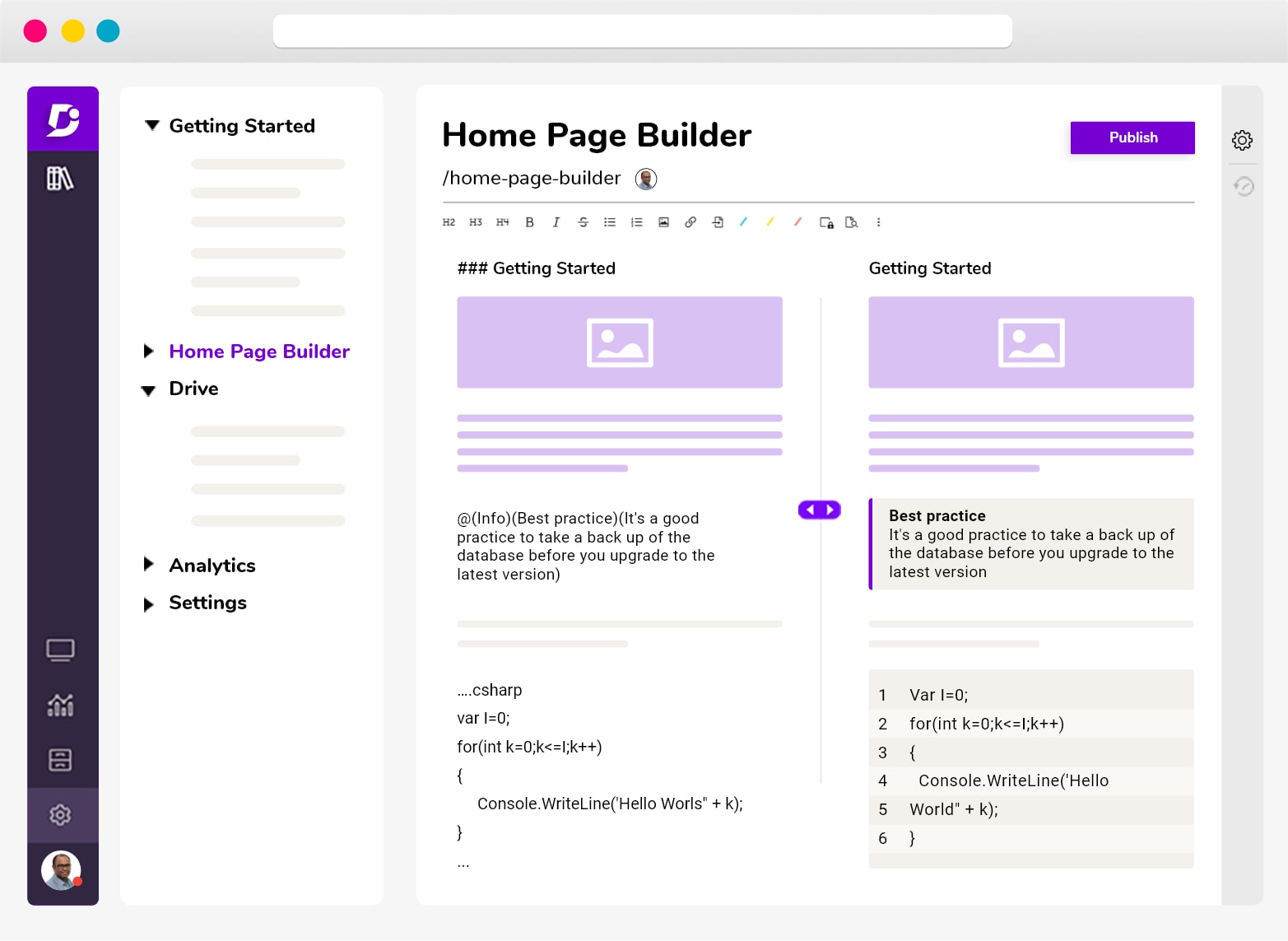
If you’re seeking an alternative to Slite, look no further than Document360. Document360 provides you with both an internal and external knowledge base for your users, highly appropriate for any kind of user. It’s easy to get started with, with WYSIWYG or Markdown support for users who want to quickly launch content creation. Document360 users don’t need to be technical specialists to create great documentation.
You’ll enjoy using Document360 for its built-in capabilities for collaboration. Content producers can be assigned different roles depending on which stage they are at in creating content. Producing content is utterly simple, along with the streamlined user experience for end users of the knowledge base.
Enterprise customers can benefit from Single Sign-on to prevent unauthorized users from accessing your knowledge base. Audit logs provide a detailed overview of the activity of knowledge base users making changes to the knowledge base.
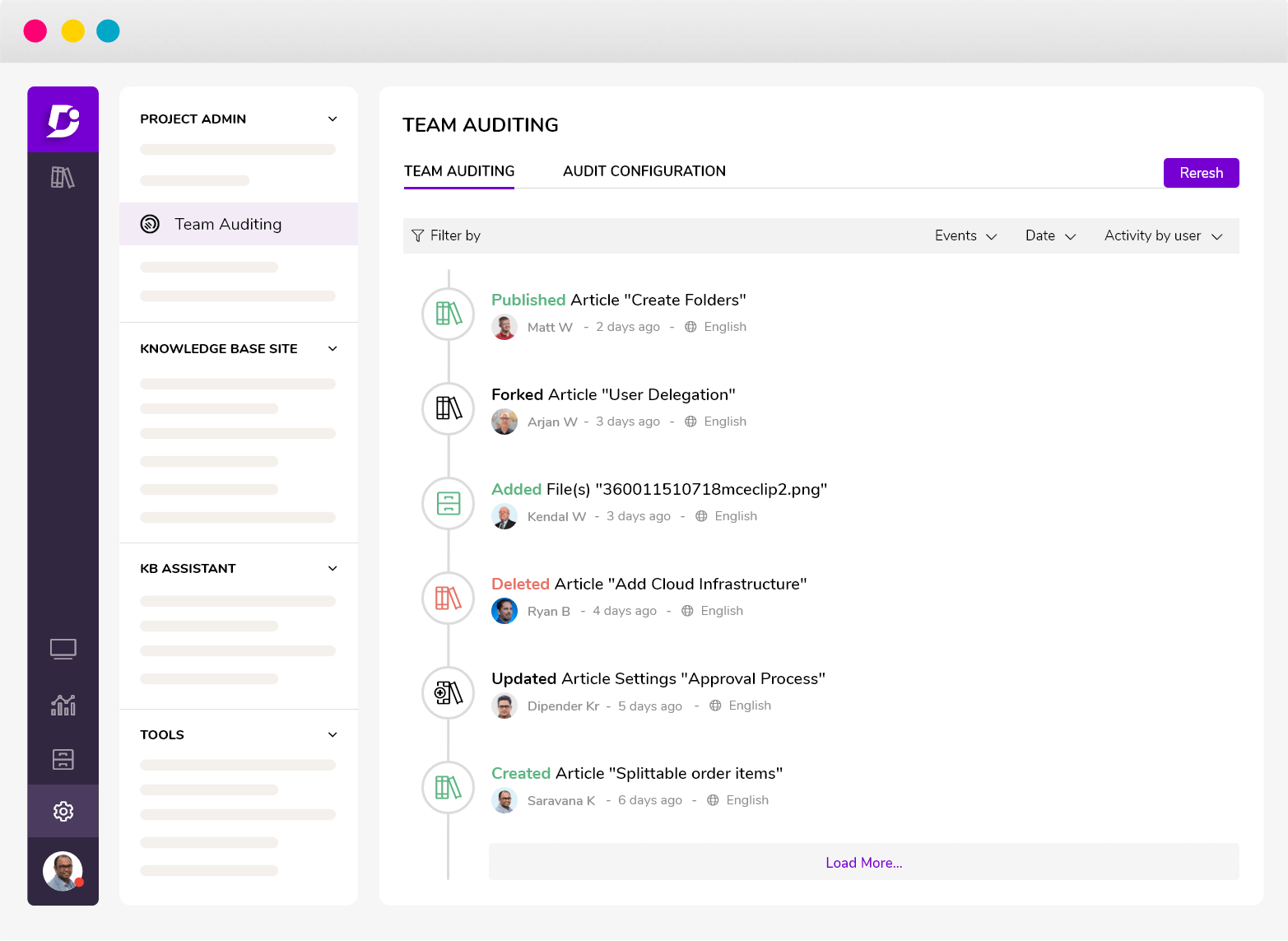
Role-based access control means you can manage how users are accessing the content, down to project, language and version level.
It’s easy for users to manage content, and to provide an easily searchable knowledge base for end users. Integrate with Slack, Microsoft Team, Chrome, Zendesk, Freshdesk, Zapier and many more. You can integrate your knowledge base with any other product using Java Script Snippet. When you adopt Document360, you need look no further for your documentation needs.
User opinion about Document360
“One of the best ever platform to create our own internal team knowledge base!”
As a project implementation manager, I was struggling to build a share link which can be accessed internally within my team. While checking for a good platform, I have seen wonderful reviews about Document360. I always wanted to try before any purchase, then I have seen great offer to try their trial service for 14 days with no credit card details!! This shows their confidence in their wonderful service. I started with trail and purchased their services. I am still using Document 360 to upload all my WIP reports and new updates which needs to be shared within my team. I also appreciate your wonderful customer service whenever I was in a need of. Keep up your fabulous service and I am recommending to all who are in my professional circle.
Source: G2 Crowd
An intuitive knowledge base software to easily add your content and integrate it with any application. Give Document360 a try!
GET STARTED
Notion
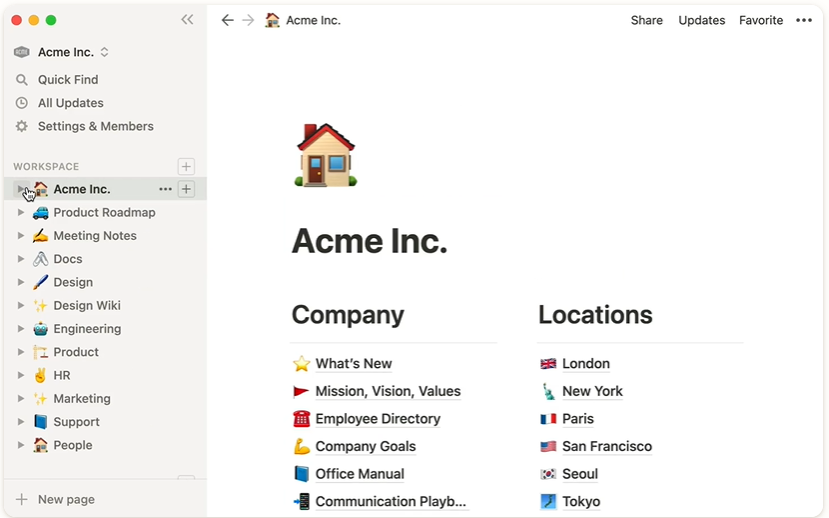

Notion is another tool that is aimed at teams who want to create internal wikis. You can connect your teams, projects and docs in Notion for seamless knowledge-sharing. Notion allows you to create a complex repository of notes that keep everyone in your team connected, bringing your wiki to life. You can present your work in boards to mimic the functionality of project management tools like Asana, so that you never lose track of a task. You have relatively endless freedom for how you present your work, making this tool a valuable internal wiki for your team.
User opinion about Notion
“The best, cleanest and smartest repository platform!”
I love Notion. My company has used this for 2 years and is one of the best purchases. We have our project plans, timelines, information and images all stored in Notion. It’s just straightforward to use and relatively lightweight for all its features. I also use it for personal use and would recommend it for businesses of any size or individual use. The future of Notion also seems exciting as they are now introducing AI writing to make writing blogs/content pieces, so I’ll be sticking around.
Source: G2 Crowd
Confluence
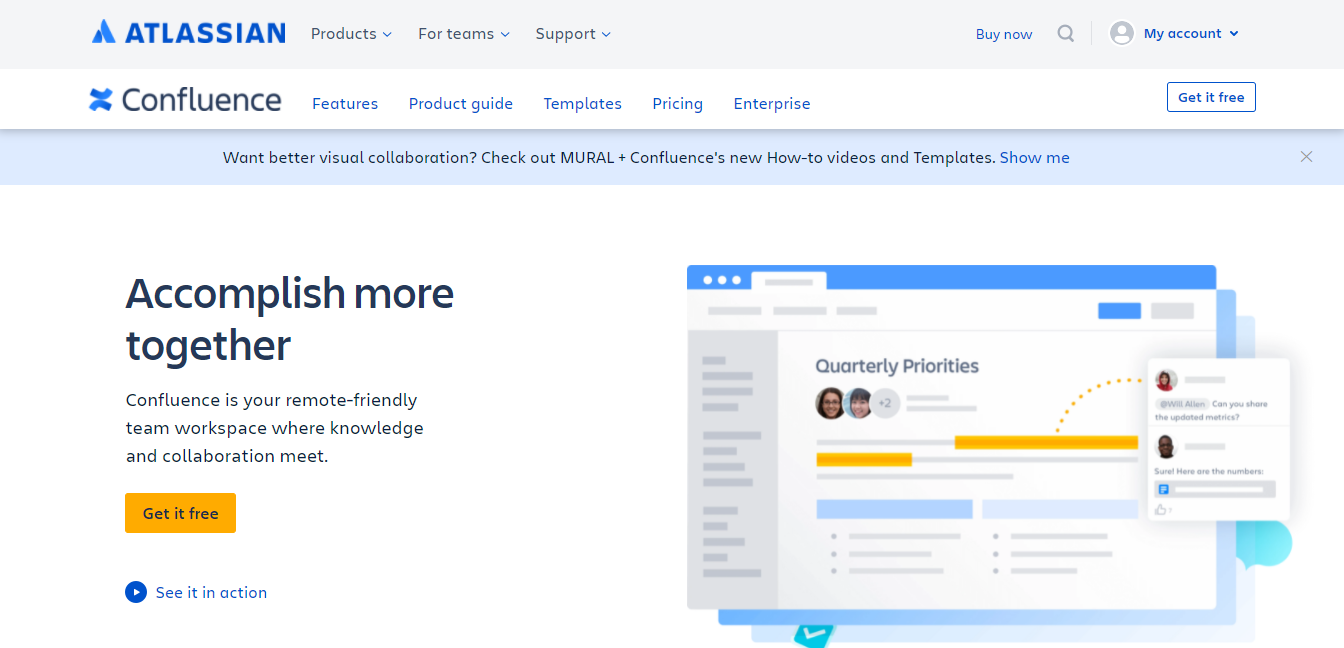

Confluence by Atlassian is a powerful alternative to Slite. Confluence has been developed for teams who want to create an internal wiki that helps them supercharge their project management capabilities. When you sign up for Confluence, you can take advantage of their many templates that help you create new documentation for your team. With Confluence, you’ll benefit from integrations with other Atlassian-owned products like Jira and Trello, which makes streamlining your workflows a breeze. Confluence organizes your spaces into pages which makes it easy to organize your team’s knowledge and manage access to documents.
User’s opinion about Confluence
“Knowledge Base for your Teams”
Confluence in an Organization can be used for various use cases such as Knowledge Base to share the documentation with team members, capture the meeting minutes of important calls, Sprint retrospectives, BRD, Project requirements, etc. Along with default templates that come with Confluence, we can also build our own templates and tweak them based on our requirements. Analytics & Team calendars are good to have features. Integrates well with Jira.
Source: G2Crowd
Check out: Document360 Vs Confluence: Which is a better Knowledge Base?
Coda


Coda is another internal wiki tool that enables you to create docs in the manner of Google Docs, with easy publishing and sharing with the rest of your team. Coda uses building blocks to seamlessly create documents for your team, including to-do lists and task boards that help you keep track of projects. Coda supports data and tables so you can move away from traditional spreadsheets, and connects with Google Calendar and Slack so you don’t have to abandon your usual workflows.
User’s opinion about Coda
“Coda is an awesome tool to create an internal wiki for the company”
Coda is an incredibly powerful tool for building an internal wiki for our company. We use it to document and store everything from customer documents to our culture and code of conduct. As a very early-stage startup, one of the things we like the most about Coda is how flexible the pricing and usage is. You only need to pay for only the people who have to create new docs. Once a document has been created other users can keep adding pages to the doc without having a full-fledged Coda license. This is a major advantage of using Coda over its competitors. Coda also has very robust community where multiple templates are available in the way of doc packs and this has been very helpful.
Source: G2 Crowd
Guru


Guru is another internal wiki that you can use to share documentation with your team. It’s a company wiki that was designed to work with your workflows so you don’t have to deviate from your usual apps in order to share knowledge with Guru. Guru has capabilities to verify individuals who share the knowledge so you always know your content is accurate. Guru uses AI to suggest employees within your organization who are best placed to help with your questions. You can share knowledge directly to Guru from apps such as Google Chrome, Slack, and Zoom.
User’s opinion about Guru
“It is very useful for small-medium companies to manage knowledge base.”
I like that Guru is not overloaded with features that are not critical for small teams, it is very easy to start utilizing Guru – just start writing your own thoughts, then formalize them each time you check the card and verify that the card is up to date. Don’t forget to add tags for easy searching info next time
Source: G2 Crowd
Read more: Get Guru Vs Document360: Which is Better Internal Wiki?
Evernote


Evernote is a knowledge-sharing tool that allows individuals to capture information as notes. Evernote is suitable for individuals who want to remember things and have access to an internal wiki that reminds them of everything they want to know. The advantage of Evernote is you can format your notes to your heart’s content, adding to-do lists, images and tables, as well as integrating with other popular tools like email software. Evernote also serves as a document storage system, enabling you to scan important documents and save them for later.
User’s opinion about Evernote
“Evernote helps me organise and share notes”
Evernote helps me keep track of vital information. It is my go to note taking application. I synchronise it with all my phones so I can have access to it anywhere I am. The sharing of file process is simple, my colleagues use it as a space for keeping documents and notes so everyone can use the materials as needed, it serves as project management app for us. For the design and interface, I like using the dark theme, and all tools for creating and editing notes are placed at a convenient location by the right side of the lower screen.
Source: G2 Crowd
slab
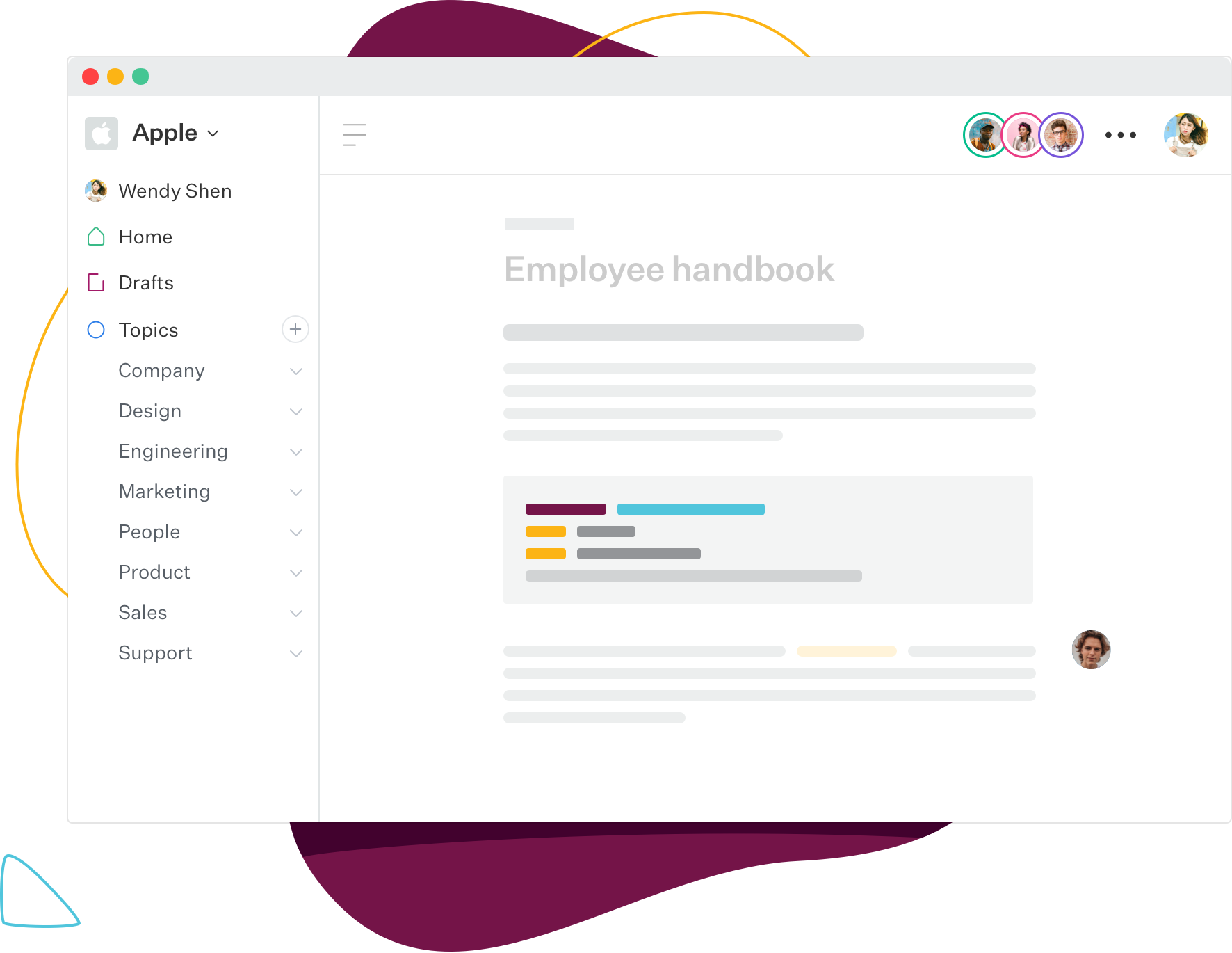

Slab is knowledge base and wiki software that lets you easily create, organize, and discover knowledge for your entire organization. Again, Slab is aimed at your internal teams so you can enhance your employees’ productivity and collaboration. The advantage of Slab is its modern user interface that enables you to create appealing content with very little effort. Slab makes it easy for teammates to browse and discover, providing vital context for content instead of relying wholly on folders. Slab’s search also indexes integrated tools like DropBox, Slack and Google Drive, so you have access to all of your content.
User’s opinion about Slab
“Unexpectedly reliant on Slab for internal documentation!”
The entire interface is very user friendly, with common elements and commands that I’m used to. This makes creating posts very quick and easy. There are many formatting options for each post as well, so you can separate out content and give it some visual excitement and hierarchy. Overall, the ease of use is probably what helped make this so widely adopted and successful within our organization.
Source: G2 Crowd
Wrapping Up
Whether you are an existing user of Slite, or considering a new knowledge base and wiki tool, it’s worth taking a look at these alternatives to Slite. Document360 in particular is suitable for teams who want both internal and external-facing content, instead of being limited to a company wiki. As a relatively new tool, Slite suffers from some bugs that make users turn to other tools on the market as a way to overcome its limitations.
Don’t make the mistake of thinking that Slite is the only knowledge base tool available. Try out some of these Slite alternatives to improve knowledge-sharing and self-service in your company. It’s worth noting that Document360 offers a 14-day free trial so you can find out if the software is right for you.
Schedule a demo with one of our experts to take a deeper dive into Document360
Book A Demo


Frequently Asked Questions
-
What is Slite used for?
Slite tool is a collaborative documentation platform that helps teams organize and share information. Team collaboration, internal documentation, meeting notes, and project planning are common uses of it.
-
What does Slite offer?
Slite includes several features, including an editor, document collection, collaboration, document sharing, search, analytics, notifications, document import, and powerful integrations.
-
What is the best alternative for Slite?
Document360 is a highly recommended alternative to Slite with a range of features that enable teams to collaborate more efficiently. Its intuitive user interface makes it easy for users to create and share documents





